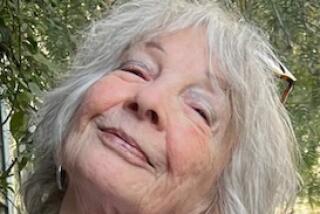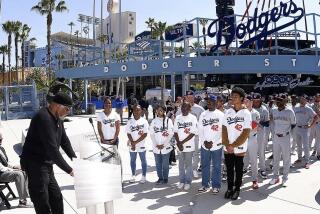Commentary : In His Day, Sugar Ray Was King of Big Apple
- Share via
NEW YORK — Emile Griffith fought more main events there, and Beau Jack holds the record for selling out the house three times in a month. But when it comes to sweet memories, no fighter provided more to Madison Square Garden’s old-timers than Sugar Ray Robinson.
“He was Mr. New York as far as boxing, and maybe as far as everything,” said John Condon, former Garden publicist and matchmaker. “He was mobbed when he walked down the streets. Everybody knew him.”
Robinson, who died at 67 Wednesday in a hospital in the Los Angeles suburb of Culver City, was an adopted New Yorker who became a local institution.
With his home on Sugar Hill, the affluent Harlem neighborhood, his bar, Sugar Ray’s, and his pink Cadillac convertible, which was apt to be parked, but never ticketed, on any street corner in town, Sugar Ray turned the Big Apple into the Candy Apple.
“He would leave that car anywhere, even the middle of Times Square, for hours on end, and no one would touch it,” Condon said. “Sometimes he would park it right in front of the old Garden and come to negotiate a deal. When he would go down, three or four hours later, he’d find the police guarding the car for him. Nobody would ever think of giving him a ticket.”
And his special home was Madison Square Garden, where he fought 21 main events, including some of his best and worst. Among Robinson’s Garden highlights were his welterweight-title winning decision over Tommy Bell in 1946; the first and fourth of his six wars with Jake LaMotta, and his memorable non-title meeting with Henry Armstrong in 1943.
Among the lowlights were Robinson’s loss of his middleweight title to Gene Fullmer in 1957, and his final fight in New York, a decision loss to Denny Moyer in 1962.
In addition, Robinson headlined four Garden-promoted shows in the city’s ballparks, including his 10th-round KO over Randy Turpin at the Polo Grounds to regain the middleweight crown in 1951, his dramatic 14th-round TKO loss to Joey Maxim at Yankee Stadium in a bid for Maxim’s light-heavyweight crown and his 15-round loss to Carmen Basilio at Yankee Stadium that cost him the middleweight title in 1957.
The Turpin fight, in which a badly cut Robinson was given one more round by referee Ruby Goldstein and responded by knocking out Turpin, drew more than 60,000 fans and attracted a record live gate for middleweights.
The Fullmer fight was an example of Robinson’s drawing power in New York. The fight had originally been scheduled for December, but an injury to Robinson had postponed the bout, and the only open date turned out to be Jan. 2, traditionally a terrible day for live events. So how did the fight do?
“We sold out the house, 18,000 seats,” Teddy Brenner, the matchmaker at the time, said.
After the loss to Moyer, Robinson got some advice from Brenner’s boss, Harry Markson, the president of Garden boxing. Markson had worked with Robinson throughout his career. “I didn’t like his performance at all against Moyer,” Markson said. “I told him I would never use him again in the Garden because I preferred to remember him as the great fighter he was. He was very upset at the time, but years later he came to me and thanked me. He said I had done the right thing.”
Robinson fought 41 times after Markson’s edict, but never again in New York. Even after he retired, however, Condon recalled how Robinson could still fill the Garden with his presence.
Emile Griffith was defending his middleweight title against Manuel Gonzalez on Dec. 10, 1965, a month after Robinson had lost to Joey Archer in what would be his last fight, and ticket sales were slow.
“So I said to Harry Markson, let’s put on a farewell to Ray Robinson,” Condon said. “I brought in the five guys he had beat for his middleweight titles, even Randy Turpin came in from London. It was nothing more than Ray Robinson walking into the ring, and we filled the place with it. Without him, the show would have been a disaster.”
Brenner, who stayed in contact with Robinson in his later years, was saddened by the deterioration in Sugar Ray, a victim of Alzheimer’s disease, over the years.
At the 1985 Marvin Hagler-Thomas Hearns fight, one of the richest middleweight title fights of all time, Robinson pointed to Hagler and asked Brenner, “Did I ever fight him?”
Hagler and Robinson never fought, of course, but Markson believes that if Sugar Ray Robinson were in his prime today, he would far outdistance the current crop of middleweights in terms of drawing power.
“I had offered him $500,000 for a third fight with Carmen Basilio, which was a huge amount in those days, but Ray turned it down, saying he could get more money,” Markson said. “It never panned out and he wound up fighting Paul Pender for $50,000 and got beat. But if Robinson and Basilio were in their prime and we did that fight today, it would double anything that Sugar Ray Leonard and Marvin Hagler ever got.”
More to Read
Go beyond the scoreboard
Get the latest on L.A.'s teams in the daily Sports Report newsletter.
You may occasionally receive promotional content from the Los Angeles Times.










